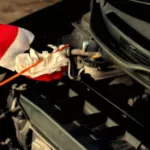Imagine this scenario: you are driving on the highway during a hot summer day and suddenly you notice steam emanating from beneath your car’s hood. Your heart rate increases as you realize that you have a coolant leak. Knowing how to identify and fix a coolant leak can save you from costly repairs and a potential disaster. In this blog post on IchieTech, you will learn how to recognize common coolant leak symptoms, locate the source of the leak, and fix it. Additionally, you will gain valuable tips on how to prevent future leaks.
Identifying Coolant Leak Symptoms
To prevent engine failure and keep your vehicle running smoothly, it is crucial to be aware of the signs of coolant leaks. In this section, we will discuss common symptoms of coolant leaks, such as puddles under the car, low coolant levels, engine overheating, and sweet-smelling odours. By understanding these symptoms, you can detect and address any antifreeze or coolant leak before it leads to more severe problems.
Puddles Under the Car
One of the telltale signs of a coolant leak is a puddle beneath your vehicle. Coolant can have a green, orange, or pink hue, depending on the type used in your car. If you notice a colourful liquid pooling near the front of your vehicle, it is likely a coolant leak. The source of the leak may be from damaged hoses, loose connections, or even small cracks in the radiator. It is essential to inspect and address any leaks promptly to avoid engine overheating and costly repairs.
Low Coolant Levels
Monitoring your coolant levels is vital in detecting a coolant leak, which could result in losing coolant. A consistent drop in coolant levels may indicate a leak, and driving with low coolant levels can lead to engine overheating and potential failure. To check your coolant level, ensure your engine is cool, and remove the radiator cap or expansion tank cap to inspect the fluid level. If you notice your coolant level is low, add the appropriate coolant type to bring the level back up, and monitor it closely as you drive. If the coolant level continues to drop rapidly, this is a clear sign of a leak and requires immediate attention to prevent further damage to your vehicle.
Engine Overheating
When there is insufficient coolant to regulate your engine’s temperature, overheating can occur. Driving with an overheating engine can lead to severe consequences, such as warping the heads, contaminating the oil, and leaving you stranded on the highway. If you experience engine overheating, it is crucial to take immediate action. If you hear a hissing sound or see steam coming from under your car’s hood, pull over immediately and allow the engine to cool down. Do not attempt to remove the radiator cap while the engine is hot, as this can cause burns from the pressurized coolant. After your engine has cooled, inspect the coolant level and address any leaks you find to prevent further overheating.
Sweet-Smelling Odors
Another symptom of a coolant leak is a sweet-smelling odour, often described as having a slightly metallic scent. This smell typically comes from the heater core, which can accumulate fluid in the plastic housing at the bottom when there is a leak. If you notice a sweet aroma coming from your engine compartment, it is essential to inspect the heater core and other cooling system components for any signs of leakage.
Common Causes of Coolant Leaks
Maintaining your vehicle’s cooling system is crucial to ensure its optimal performance. One of the most common issues that can arise in the cooling system is coolant leaks. There are several reasons why coolant can leak from the system, including damaged hoses, a faulty radiator cap, a corroded radiator, and a blown head gasket.
Damaged Hoses
Rubber hoses can crack or wear down over time, leading to leaks. Regularly inspecting the radiator hoses for signs of cracks, swelling, or unusual softness is essential to identify potential leaks before they cause any significant damage.
Faulty Radiator Cap
A damaged or loose radiator cap can cause a coolant leak by reducing the pressure in the system. To diagnose a radiator cap leak, check the cap for the correct pressure and refer to your car owner’s manual for guidance. Replacing a damaged or loose radiator cap can prevent potential engine damage.
Corroded Radiator
Corrosion and rust can cause small holes in the radiator, leading to coolant leaks. Regular radiator maintenance, such as flushing the coolant and inspecting the radiator for signs of corrosion, can help prevent leaks and ensure the cooling system functions optimally.
Blown Head Gasket
The head gasket is a crucial component of the cooling system, regulating the flow of coolant through the engine and preventing coolant leakage into the engine oil or combustion chamber. A blown head gasket can cause engine oil and coolant to mix, which can lead to severe engine breakdown. It can also cause coolant to leak out of the engine, resulting in decreased cooling capacity as the coolant level drops. If you suspect a blown head gasket, it’s essential to seek professional assistance to diagnose and repair the issue promptly. Driving with a blown head gasket can result in severe engine damage and costly repairs, so it’s crucial to address this problem as soon as possible.
How to Locate the Source of a Coolant Leak
If you suspect your vehicle has a coolant leak, finding its source is the first step to fixing the problem. In this section, we will provide you with tips on how to locate the source of a coolant leak through visual inspections and pressure tests. By identifying the leak’s origin, you can take the necessary steps to repair it promptly and prevent further damage to your vehicle.
Visual inspections are an excellent way to start. Look for signs of wetness or dryness and perform a visual inspection of the cooling system components, including the coolant reservoir. Check for coolant residue on the ground, as well as any swelling, cracks, or unusual softness in the radiator hoses.
Check the following components for any signs of wear or damage that could be causing a leak:
- Radiator cap
- Head gasket
- Valves
- Engine block
Remember, the sooner you locate and address the leak in your car’s engine, the less likely you are to experience severe engine damage.
If a visual inspection fails to identify the source of the leak, a pressure test is a reliable way to locate it. This diagnostic tool involves pressurizing the cooling system and inspecting it for leaks. A technician will attach the pressure tester to the cooling system, pressurize it, and then inspect the system for any leaks.
If a pressure test fails to identify the source of the leak, it may be advisable to consult a professional technician for further assistance.
Recommended: How to Identify and Fix a Power Steering Fluid Leak
Fixing a Coolant Leak
If you suspect that your coolant is leaking, it is important to take action quickly to avoid potential engine damage. In this section, you will find solutions for repairing different types of coolant leaks, ranging from simple DIY fixes to seeking professional assistance.
By addressing the leak promptly, you can prevent potential engine damage and keep your vehicle running smoothly.
DIY Repairs
For simple external coolant leaks, you can attempt to repair them yourself by replacing damaged hoses or faulty radiator caps. However, if you suspect an internal coolant leak, it is best to consult a professional mechanic. Follow your vehicle’s manual for guidance on performing these repairs, and always ensure the engine is cool before working on the cooling system.
If you are uncertain of your ability to perform the repair or the issue seems more complicated, it is best to consult a professional technician for help.
Professional Assistance
For more complex issues such as internal coolant leaks or blown head gaskets, it is necessary to seek professional help. A skilled technician can diagnose and repair the problem, ensuring your vehicle’s cooling system functions optimally and preventing further damage to your engine.
Do not hesitate to contact a professional if you are unsure about the source of the leak or the necessary repairs, as delaying the fix can lead to more severe consequences and costly repairs.
Preventing Future Coolant Leaks
Preventing a coolant leak is one of the best ways to avoid the stress and expense of fixing it. This section will provide preventative measures to help you steer clear of coolant leaks in the future. These measures include regular maintenance and the use of high-quality coolant.
By taking proactive steps, you can ensure that your vehicle’s cooling system remains in good condition and avoid potential engine damage.
Regular Maintenance
Routine maintenance of your vehicle’s cooling system is critical to preventing coolant leaks. The following are some steps you can take to maintain your cooling system:
- Regularly check your coolant levels.
- Inspect hoses and other components for signs of wear and tear.
- Conduct pressure tests to identify any potential issues.
By following these steps, you can identify and address potential issues before they become more serious.
Regular maintenance not only helps prevent leaks but also ensures that your cooling system is functioning optimally, which can save you from costly repairs down the line.
High-Quality Coolant
Using high-quality coolant can help minimize the risk of corrosion and other potential issues that could lead to leaks. When selecting the appropriate coolant for your vehicle, consider factors such as the type of engine, climate, and manufacturer’s guidelines. Also, verify the expiration date of the coolant and ensure it is still viable for use.
By investing in high-quality coolant, you can protect your engine and extend the life of your vehicle’s cooling system.
Conclusion
In conclusion, understanding how to identify and fix a coolant leak is crucial for maintaining your vehicle’s performance and preventing costly repairs. By recognizing the symptoms of a coolant leak, understanding common causes, locating the source of the leak, and fixing the issue, you can keep your engine running smoothly and avoid potential damage. Remember to prioritize regular maintenance and use high-quality coolant to prevent future leaks. Stay proactive, and your vehicle’s cooling system will thank you for it.









